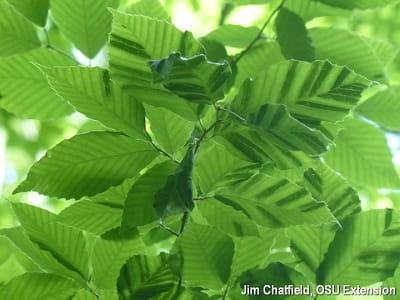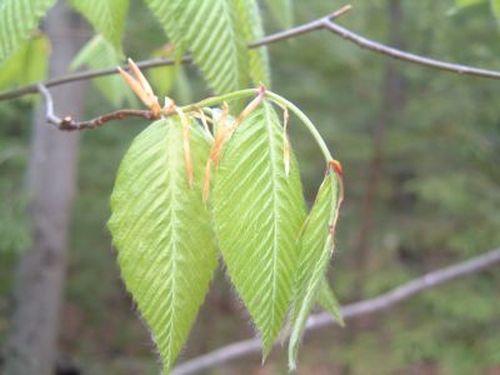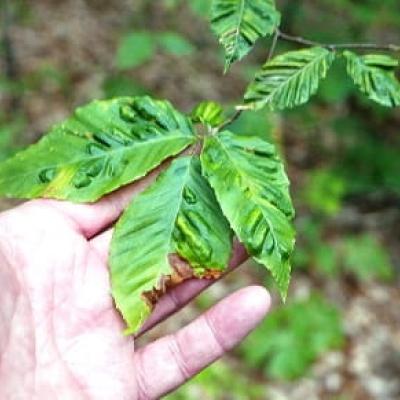- Tags:
- Forestry,
- Working Forests

Can you spot the early signs of beech leaf disease? (Photo courtesy of Jim Chatfield, OSU Extension, from Michigan Invasive Species)
Forest Society foresters attended another great presentation at the recent NE Spciety of American Foresters meeting earlier in March. But, one of these presentations provided some grim news about one of our more common tree species.
If the American Beech tree didn’t have enough on its plate already, this species has another pest to content with called “beech leaf disease” and is proving to be much more destructive. Not to be confused with the disease that has plagued the tree when it first arrived in NH in the 1950s, called beech bark disease which has since become widespread in the Northeast inflicting often lower productivity with some trees dying after many years of infection.

Cameron McIntire, a Plant Pathologist with the USDA Forest Service, presented some of the new research being undertaken within plots across the northeast. Beech leaf disease was first discovered in 2012 in Ohio along the shores of Lake Erie. (See map here) Since this time, it has spread exponentially across the eastern US and is now found as far east as Penobscot County in Maine in as little as just 10 years.
In New Hampshire, it was first found last year in a single European beech tree in a residential setting in Derry. Since then, it has been found in two other southeastern New Hampshire locations.
Researchers have pinpointed a common theme with the disease that in each case where they observe the sign of the disease a nematode seems to be a large part of the culprit. This nematode was so new to science that it was given a name only just recently in 2019 called Litylenchus crenatae.
Nematodes that inflict damage on trees are not widely understood or have much institutional knowledge among forest health professionals.
Are these microscopic worms acting alone? That’s the big question. Also, how are these tiny worms moving from tree to tree and have traveled as far as they have in such a short amount of time?
Birds, mites and wind are at the top of list who feed on beech buds and could be passing this disease between trees. Water is necessary for the nematode to become mobile and we have no shortage of that here in the northeast.

Once this pest increases its numbers to a certain point,the tree eventually stops producing leaves. Losing the ability to photosynthesis, the tree stops growing and dies. Death can occur in as little as 2-5 years, per this report.
Beech is the 10th most abundant tree species looking at the total number of growing stock trees in the size class of 5 inches and higher. It is also the 4th most abundant tree species in the sapling size class, making up a much higher proportion of the understory of our forests here in New Hampshire.
Loosing beech in our forests will be a substantial hit to not only the forest economy and ecosystem but particularly to the wildlife that depend on its nutritious mast (nuts) in the fall.
It will be interesting to see what comes of the research that is aiming to learn more about this disease and what possibly might be done to save one of our most abundant tree species. Unfortunately, the news lately is not looking good for yet again another tree species in our forest.
